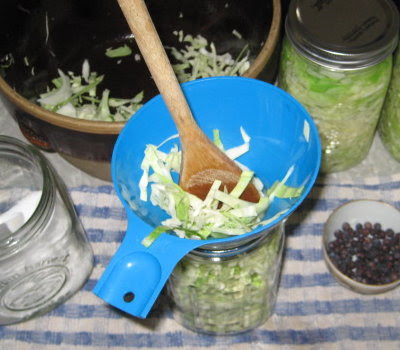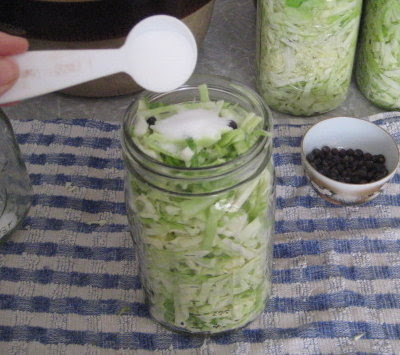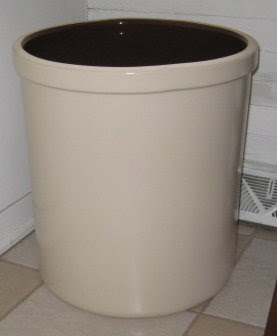 Reading this book was like finding a missing puzzle piece. (Click the image for a closer look at the cover.) I've often wondered how people preserved foods without canners and freezers. Preserving Food without Freezing or Canning: Traditional Techniques Using Salt, Oil, Sugar, Alcohol, Vinegar, Drying, Cold Storage, and Lactic Fermentation
Reading this book was like finding a missing puzzle piece. (Click the image for a closer look at the cover.) I've often wondered how people preserved foods without canners and freezers. Preserving Food without Freezing or Canning: Traditional Techniques Using Salt, Oil, Sugar, Alcohol, Vinegar, Drying, Cold Storage, and Lactic FermentationSome of these techniques were already familiar to me. The chapter that really caught my eye however, was chapter 3, "Preserving By Lactic Fermentation." In browsing through the recipes, I immediately noted that many of them were for sauerkraut. All the recipes I'd ever seen for sauerkraut included water bath canning. It never occurred to me that sauerkraut had been made for centuries before canning had ever been invented.
We live in an age when food preservation is done largely by sterilization. Destroying microbes and pathogens which are dangerous to us makes sense. On the other hand, we also understand that certain "cultured" foods are both healthful and nutritious, deriving benefit from friendly bacteria which sterilization would destroy. Take yogurt for example. Or sourdough bread.
So what exactly is lactic fermentation? (Also called lacto-fermentation). It is the process by which common, friendly bacteria called lactobacilli, convert the starches and sugars of vegetables and fruits into lactic acid. Lactic acid is a natural preservative which has the added benefit of increasing the vitamin and enzyme content of foods, as well as making them more digestible.
Sauerkraut is probably the most well known lacto-fermented food and it is easy and simple to make. From the book, I used the recipe "Sauerkraut in Glass Jars," (pg 68). The basic ingredients were cabbage and salt.
 While I scalded several wide mouth, quart canning jars and lids, I chopped the cabbage.
While I scalded several wide mouth, quart canning jars and lids, I chopped the cabbage. This was packed firmly into the jars. The recipe called for either juniper berries or bay leaves for flavoring. I had dried juniper berries in my herb cabinet, so I used these, about 10 per quart.
This was packed firmly into the jars. The recipe called for either juniper berries or bay leaves for flavoring. I had dried juniper berries in my herb cabinet, so I used these, about 10 per quart. After the cabbage was packed in, one tablespoon sea salt was added to each quart. The sea salt prevents bad bacteria from putrefying the cabbage before enough lactic acid has been produced to do the job itself. Whey can also be used as a starter, but that's another post for another day.
After the cabbage was packed in, one tablespoon sea salt was added to each quart. The sea salt prevents bad bacteria from putrefying the cabbage before enough lactic acid has been produced to do the job itself. Whey can also be used as a starter, but that's another post for another day.The jars were then filled with hot water. The water needs to be non-chlorinated, so I let mine sit for 24 hours. (Chlorine evaporates out in 24 hours, something I learned when I used to keep tropical fish.)
 One cabbage yielded three quarts jars. These must sit in the kitchen (room temp) for three days and then they can be put into storage. The directions said to wait one month before eating. For best keeping, storage should be cool and dark, like a root cellar or unheated room.
One cabbage yielded three quarts jars. These must sit in the kitchen (room temp) for three days and then they can be put into storage. The directions said to wait one month before eating. For best keeping, storage should be cool and dark, like a root cellar or unheated room.The fermentation process is anaerobic, so the important thing is that the cabbage is completely submerged in the liquid. However pressure builds up, so the jars must be opened daily to release it as the cabbage ferments. Traditional stoneware crocks do not have airtight lids and so this would not be a problem.
 Speaking of stoneware crocks, my husband, who is ever supportive of all my endeavors, brought me home a ten gallon crock! I had been researching stoneware crocks online and found the best price at Pressure Cooker Outlet, though unfortunately, shipping doubled the cost. Ironically, the next week he traveled through Hillsville, VA, where their retail store (Red Hill General Store) is. Unfortunately they were sold out of everything but the ten gallon size. Guess who's going to be trying that recipe for whole cabbage sauerkraut! :)
Speaking of stoneware crocks, my husband, who is ever supportive of all my endeavors, brought me home a ten gallon crock! I had been researching stoneware crocks online and found the best price at Pressure Cooker Outlet, though unfortunately, shipping doubled the cost. Ironically, the next week he traveled through Hillsville, VA, where their retail store (Red Hill General Store) is. Unfortunately they were sold out of everything but the ten gallon size. Guess who's going to be trying that recipe for whole cabbage sauerkraut! :)And last but not least, because I love to share what I'm learning, following are some interesting links on this traditional food preservation technique (some with recipes):
Fermented & Raw - Food Renegade
Lacto-Fermentation: A Healthy Way to Preserve Your Harvest - DestinySurvival.com
Benefits of Lacto-Fermentation - The Nourishing Gourmet
Fermented Food for Beginners : Lacto-Fermented Vegetables - Nourishing Days
Vegetable Fermentation Further Simplified - Wild Fermentation
Comparison of Vegetable Fermentation Methods - The Nourishing Gourmet
What I've Learned About Sauerkraut photos & text copyright
October 2009 by Leigh at http://www.5acresandadream.com/

22 comments:
We did a lacto fermented sauerkraut a couple of months ago. I really want to try it but I am afraid to. :D
What do I think...I think I should come to your house for a sampling party! Good job, I love saurkraut.
What are the other items that can be preserved this way? Pickles?
Beautiful crock!
Oh leigh I just enjoy learning so much from your blog. I can't wait tell I get a garden in next spring to try everything that I learn from you.
My hubby loves saurkraut!
http://www.foodnetwork.com/recipes/alton-brown/sauerkraut-recipe/index.html
I would like to try this, but I've got no one who wants to EAT the sauerkraut. I like it with Brats, but the pickies don't like Brats either. :p Oh well.
Robin, I know what you mean, *LOL. I think my first taste will be with much trepidation!
Theresa, actually I could use your taste buds! Neither Dan nor I have eaten much sauerkraut and from what I gather, lacto-fermentation is something of an art. I'm learning in my research that before commercial processing of pickles, this was the way they were made. Lacto-fermentation evidently isn't neither totally controllable nor predictable (rather like making bread), so industry had to come up with a standardized recipe and started using vinegar instead. I'm wondering if the vinegar is the reason I've never cared much for pickled foods.
Julie, thanks! I have always considered myself an eternal student. If I ever run out of things to learn, I'd be bored out of my mind! But, the teacher in my always wants to pass on what I'm learning. I'm just pleased others find it interesting too.
Renee, thanks for the recipe! You have the same problem I do, no one here really eats sauerkraut. I'm hoping this experiment will change all that however. You should try the recipe anyway. If your family says "no way," you could always take it for a pot luck supper somewhere. :)
I'm so happy that you share what you've learned on your blog!!
Saurerkraut doesn't agree with me but last week I cooked it with chicken in the crock pot and served it over mashed potatoes. Very good!!
Interesting, I don't really like kraut or pickled food either, but maybe as you say it could be the vinegar. My mom says that in Cuba when they slaughtered hogs the meat was stored in pork lard to preserve it. I sure it was processed before that but she says she can remember my g-grandma going under the sink and pulling out chunks of pork to fry up.
Thank you very much for all this wonderful information.
So, for how long do you have to open the jars daily? Every day until you eat it, or just the first three days?
I love sauerkraut - must be the large amount of German blood running through my veins!
Barb, that sounds yummy! It can certainly be cooked as well as eaten raw. What I'm learning from my reading is that small amounts of raw lacto-fermented food daily does wonders for our digestive and immune systems. I'm very interested in trying other foods besides cabbage.
Deep End, interesting! It seems to me that I remember from the Little House series that that's how the pioneers stored raw pork sausage, packed away in lard.
Benita that's a good question and I'm not sure of the answer. I only found one source which mentioned expansion and leaking and this proved to be my case as well. One recipe using canning jars (which I found afterward) says to leave 1 inch headroom in the jar before adding the liquid. I filled mine to the top so there was no room for the fermenting gases to expand. For now, I'm leaving them covered loosely and will just check on them daily. Next recipe, I'll leave more headroom and see what happens.
well - being german, what can I say? I love sauerkraut:)) I suppose it's a bit of an acquired taste - germans and also eastern europeans are famous for this stuff. our special sauerkraut crockpot looks different though: it has a double rim, into which you can give some water. the sauerkraut is mashed down either with your bare hands (together with the salt this opens the cells of the cabbage and releases its juices - which means you add either no water or only very little) or with a potato masher. you then cover it with a weight such as a sterilized stone (the special pot comes with two half circles), which weighs the whole lot down. you put the lid on top - and fill the double rim with water to keep out harmful bacterias... btw, you can do runner beans the same way and lots of other veggies too..... famous are beetroot in our family - esp. for the sensational colour:))
if you don't like your sauerkraut, it might be more palatable if you wash it in running water before cooking (or eating raw). you can braise it with pineapple pieces, some grapes or even a bit of honey. or you can mix it with grated potatoes, a little flour and some eggs - to make small fritters... sorry for the rant - I really do like my kraut:))
I grew up eating sauerkraut baked on top our cabbage rolls. I loved it that way. My oldest recently discovered that he likes it on...well, most anything so I really should learn to make it too. Love your photos because that is the way I learn best. I wonder what it will taste like compared to the usual store-bought kind?? I don't think I've ever had fermented anything, really. ;-)
Oops, forgot that I wondered what you usually do with Juniper berries, I picked some on a hike a few weeks back and just have them sitting on the counter. Not sure if I figured I was going to learn to make my own gin or what. (kidding) ;-)
Interesting that this is another technique for food preservation. I definitely have seen different jars of pickled or otherwise preserved veggies in different countries.
Off the tops of our heads, Jim and I can remember cauliflower, peppers, tomatoes, onions, beans and jars with a mixture that contained carrots and other pale things. I was always too much of a chicken to actually taste these things - so I don't know if they were lacto fermented, pickled, or something else.
I wish I liked sauerkraut!!
Sue
Hi Leigh, you'll see on my blog that I got 20# of sauerkraut started last night. I do so hope that it turns out, because I love the stuff. For those who don't like the strong taste, it is also good in a casserole with diced potatoes, onions, diced or sliced sausage (mine is homemade veggie sausage) and a thick cream sauce. MMM! But I am very interested in how to preserve it after it's "done." I understand that water bath canning would keep it safe but also kill beneficial goodies. Not enough room in my small frig to keep it there. Can I put it in jars without processing and keep it safely? I'd love to know! (And if I ask my dietitian mother, she will INSIST that I can it!)
Bettina, thank you for all the info and ideas! I've seen the fermenting pots, but am not ready to sink that kind of money into it at the moment. I've got two books on the subject which go in to quite a bit of detail with lots of recipes. From your description though, I already see how I can do a better job next time. Even if we don't care for this batch, I'm determined to keep on trying and learning till I get one that we really like.
Heather, I wondered about how homemade sauerkraut compares to store bought stuff too. One thing's for certain, the sauerkraut from the stores has been canned which kills all the good bacteria and enzymes. I don't know if this would change the taste much or not. I'm not entirely certain how well my first batch will turn out, so it probably wouldn't be good for a taste test. :)
I use juniper berries in kidney/bladder tinctures. I am thinking that I need a juniper, but haven't figured out yet where to put it. It would be nice to gather berries locally though.
Sue, that is so interesting. I never realized it, but lacto-fermentation is evidently practiced world-wide. I wish I had recipes for all the things you mention. I never cared much for sauerkraut either, except on Reuben sandwiches. I am determined to develop a taste for it however. And with all the ideas I'm getting in these comments, I don't feel like I can go wrong
Michelle, 20 pounds?!? You're a braver woman than I. *LOL Thanks for all the yummy ideas too. I never realized how much could be done with kraut until you guys.
For keeping, everything I've read says cold storage, like a root cellar or the coolest part of a basement. The lactic acid should keep it safe. And actually, you should just be able to leave it in that container and just help yourself as you wish.
I've got both a 3 gal. and 6 gal. crocks but never made kraut...yet. You may just inspire me, Leigh.
And there's that salt again. LOL!
Hah! I knew Michelle would weigh in since she's been cabbaging. I gave her my favorite Cole Slaw recipe because I'm just not much of a sauerkraut fan. I like it on a Polish dog, but I really can't eat that many of them. I applaud your work just the same. Really.
Kathy, lucky you to have those crocks! You'd better get fermenting. :)
Sharon, that sounds like another good way to eat sauerkraut. Michelle mentioned on her blog that made cole slaw too, now I know it was your recipe! If we weren't happy with ours, I'd ask you for a copy. But I'm not sure I dare change something Dan already likes.
me again - about the juniper: they are dioecious, so you need at least one boy and one girl (but the male can pollinate several females, if they're close enough!). you can use juniper as a spice too, e.g. for game recipes, dark sauces or marinades. and if all else fails - you can dye with them:))
Bettina, I've really appreciated all your input on this! Both the sauerkraut and the junipers. I'm glad you told me about the junipers. I will need to make sure I get one of each. Do you make sauerkraut? Do you have a favorite recipe?
I love sauerkraut...and the best way to make it is the crock.
Helps if you have a krauthobel to put right over it and shred as you go!
I once filled a 50lb crock and kept it in the garage (safe as long as you don't freeze). We just helped ourselves as we needed. It lasted a long time!
A good useful tip: Line the crock with a black plastic bag, when you fill to the top, place a large dinner plate on the top of the cabbage. Then slightly fill another black plastic bag with water (tie closed), and place on top of the plate. This will weigh down the plate and overflow to the edges, so it allows air to escape, but keeps things clean.
Just now came across your blog, glad you were able to find a crock. During the fall it is hard for us to keep those in stock, they go quick. Hope you've been able to use your crock many times over the last 3 years.
Post a Comment